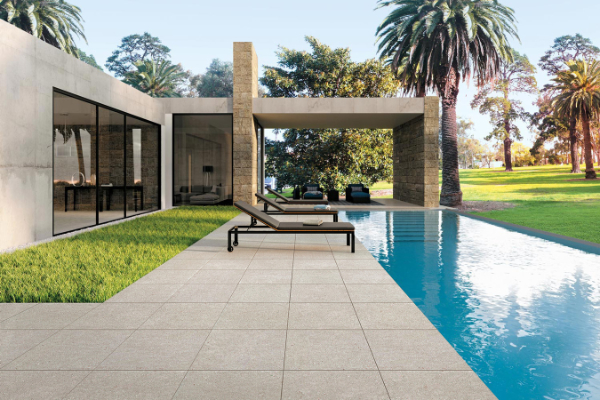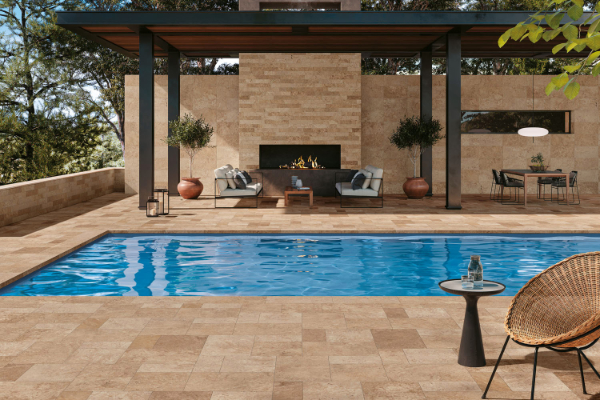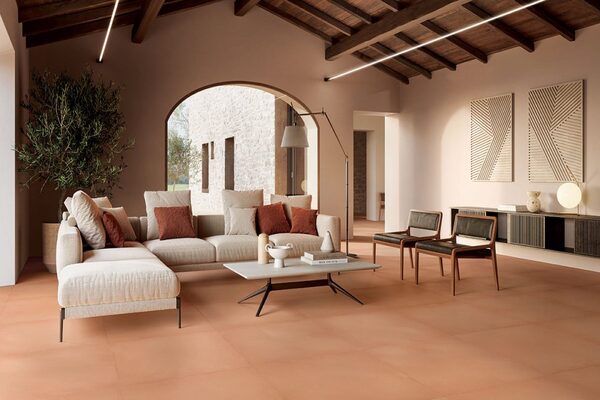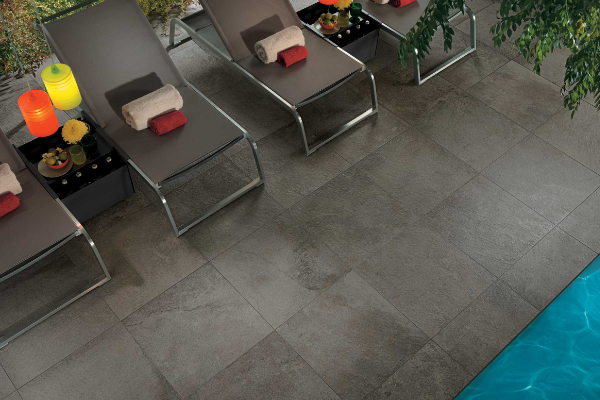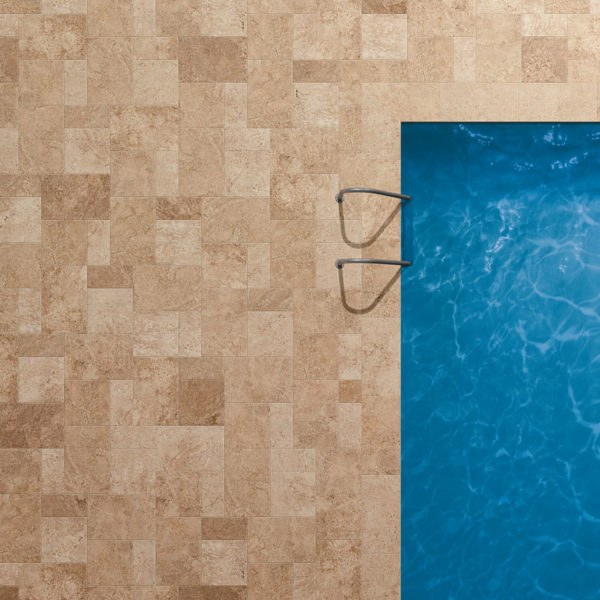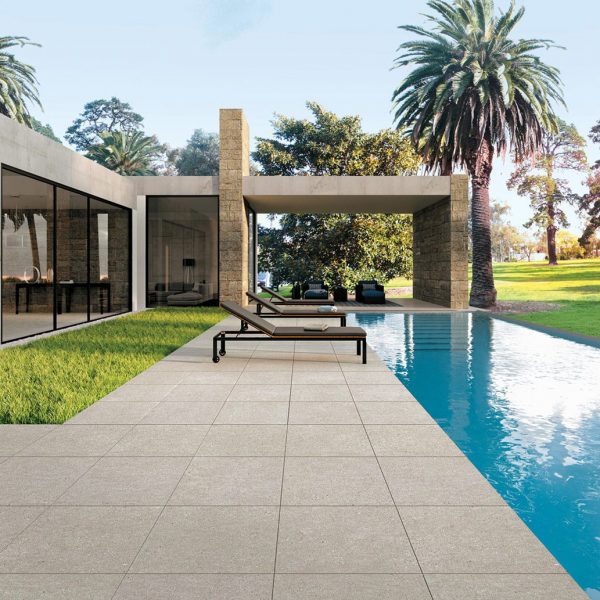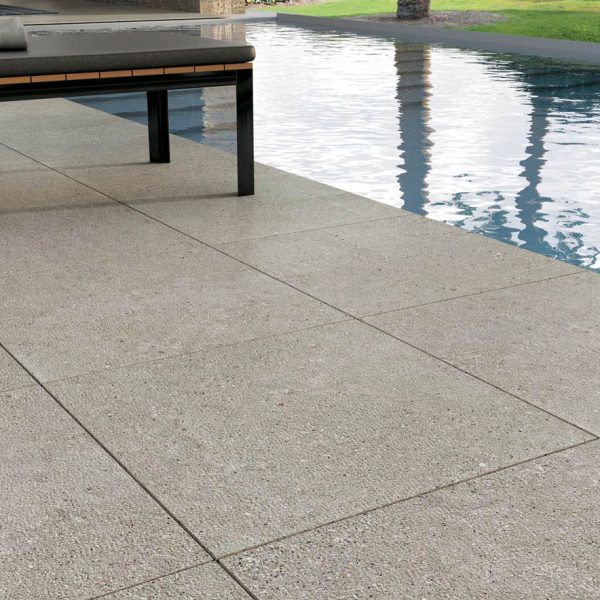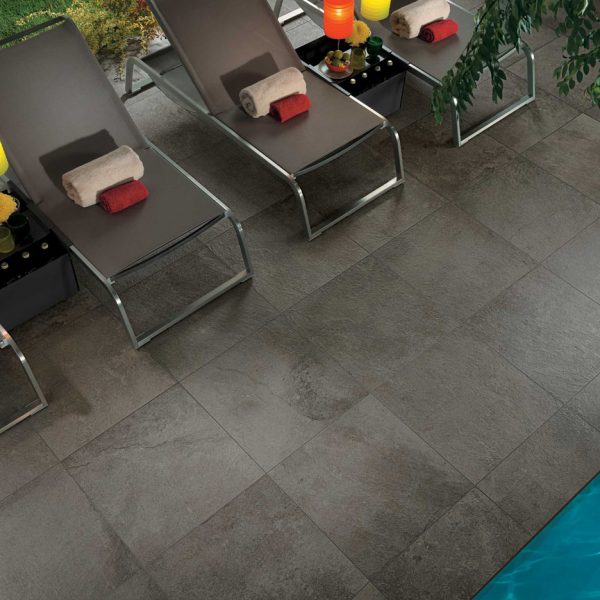Being able to walk barefoot on your swimming pool tiles, which are pleasant to the touch, before cooling off at home and walking on a single flooring, is now a possibility. Novoceram has designed tiles for swimming pools to ensure continuity between the interior and exterior for greater harmony. In addition, thanks to the many aesthetic effects of ceramic pool tiles, they are easy to combine with any decoration, from classic to the most contemporary. Your indoor or outdoor space will be completely enhanced and will inspire relaxation and escape, while ensuring perfect safety.
Pool Tiles
Our pool tile collections
Porcelain tiles for swimming pool: why is it the ideal covering?
It is possible to lay pool tiles anywhere, as they are suitable for pools and their surroundings, as well as for pool changing rooms and common areas. They are equally suitable for private home pools as well as public pools or large hotel pools. This versatility creates a form of aesthetic continuity within the space and blurs the boundaries with the surrounding environments. Moreover, thanks to the technical properties of porcelain swimming pool tiles, it becomes a favourite among pool flooring. Indeed, its non-slip nature and resistance adequately meet the requirements of a swimming pool area.
The anti-slip properties of swimming pool tiles
It is essential to look at the non-slip standards of tiles for swimming pool in order to choose the right flooring. Indeed, it is extremely important to choose it well in order to prevent falls.
Tiles for the pool access
In order to choose suitable tiles, the CSTB – Scientific and Technical Centre for Building – has established the UPEC classification, which aims at evaluating flooring according to its intended use by studying 4 criteria: the resistance to wear and tear, to punching by furniture, to water, and to chemicals. For swimming pool tiles intended to decorate areas with barefoot traffic, tiles should have a UPEC classification that is at least equivalent to U3 P3 E3 C2.
According to the DIN 51097 standard, which evaluates the resistance to slipperiness in areas where people walk barefoot, the A+B+C classification is mandatory for all immersed parts of the pool (such as stairs, ramps and footbaths). On the other hand, this same norm establishes that swimming pool tiles must at least be A+B for the bottom of the pool, above 1.5 m in depth, while no classification is required for areas that are 1.5 m deep or more.
Tiles for pool deck
Once you have chosen your pool flooring, it is then time to consider the design of the pool deck and choose the tile for the pool surroundings. The non-slip version of ceramic pool tiles is ideal for covering the pool deck.
According to the DIN 51097 standard, pool deck tiles require an A+B classification, but Novoceram recommends selecting a pool deck tile classified as A+B+C and R11 (according to the DIN 51130 standard which defines slip resistance with shoes). Since these characteristics guarantee maximum safety in terms of slip resistance, they are particularly important in a context that could otherwise be dangerous.
Swimming pool porcelain tiles: 2cm thick in the Outdoor Plus range
The Outdoor Plus range includes 20mm thick tiles that can be laid in exterior environments. Thus, the 2 cm thick tile can be a wise choice in view of its many advantages, especially for pool decks.
Outdoor Plus pool deck tiles can be laid in a variety of ways, besides the traditional screed method. Indeed, tiles for pool surroundings can be laid without glue, on gravel, on grass for a Japanese style or on pedestal supports. These processes are faster, allow water drainage and make the tiled pool deck immediately walkable. However, this system is not suitable for pool surroundings where the tiles must be glued.
The 2 cm thickness also allows for the creation of special pieces and coping tiles, which are essential for an optimal finish of the pool edge directly by machining the tiles for perfect coordination.
The Outdoor Plus pool deck tiles are available in a wide range of colours and aesthetic effects. It is therefore possible to choose modern swimming pool tiles or more timeless models such as a stone effect, for example. In addition, there is a wide variety of pool tile sizes to enhance any space.
The effects and colours of tiles for swimming pool
Novoceram produces collections of pool ceramic tiles that allow you to design a unique and original pool area. Indeed, it is easy to completely customise not only your pool, but also its surroundings thanks to pool deck tiles and their various aesthetic effects.
Thanks to the wide variety of swimming pool tiles effects, you can combine your porcelain tiles to the style of your garden. Natural materials are a first source of inspiration. Indeed, pool tiles reproduce the aesthetics of wood with striking realism since the surface of the tile even has the imperfections that shape the identity of natural parquet flooring. This option softens the atmosphere and most importantly brings warmth and brightness to your space.
Another possibility is to choose stone effect pool tiles to adorn your water area with character and elegance. Thanks to the new technologies being used, porcelain stoneware perfectly reproduces the beauty of stone and its authentic charm that comes from its timeless nature and the work of time. The stone look appears to be a good compromise between the authenticity of the old and the youthful look that it brings. In other words, stone effect tiles create a contemporary atmosphere that will enhance your space for years to come.
For industrial decorations, you can also consider concrete effect tiles for pool. This solution embodies pure modernity, and its neutral appearance, rich in details, is a perfect match for urban or minimalist decorations.
It is worth mentioning that Novoceram collections are usually available in an indoor version and a non-slip version for the exterior. In this way, pool ceramic tiles can correspond to your decoration style and create a continuity with your indoor spaces.
Finally, it is important to choose the colour of your pool tiles so that the decoration is in harmony with the environment and nature. Swimming pool tiles have many different colours, from the darkest and deepest to the lightest and warmest, to satisfy any aesthetic requirement. For example, grey pool tiles are perfect for any style of environment and can be easily combined to a variety of shades. On the other hand, beige swimming pool tiles seem to be suitable for a warmer and brighter atmosphere.
What are the sizes of pool tiles?
Novoceram collections are available in a wide range of formats, which can also be laid according to a modular pattern. It is possible to choose between:
- Small tiles for swimming pool, which includes 20×20 cm and 30×30 cm. The mosaic tile size, which is a true classic, also belongs to this category.
- Medium pool tiles – 45×45 cm or 60×60 cm. These dimensions are suitable for all environments as they are defined as standard. The 60x60cm tile size is particularly suitable for the realization of modular pool edges in the 30×60 cm format.
- Large swimming pool tiles, among which are the 80x80cm and rectangular sizes such as 30×120 cm. These sizes are mainly recommended for spacious outdoor environments with a sober appearance, as they have the ability to provide a sensation of volume. Moreover, the rectangular shape offers an original result, different from the traditional square format.
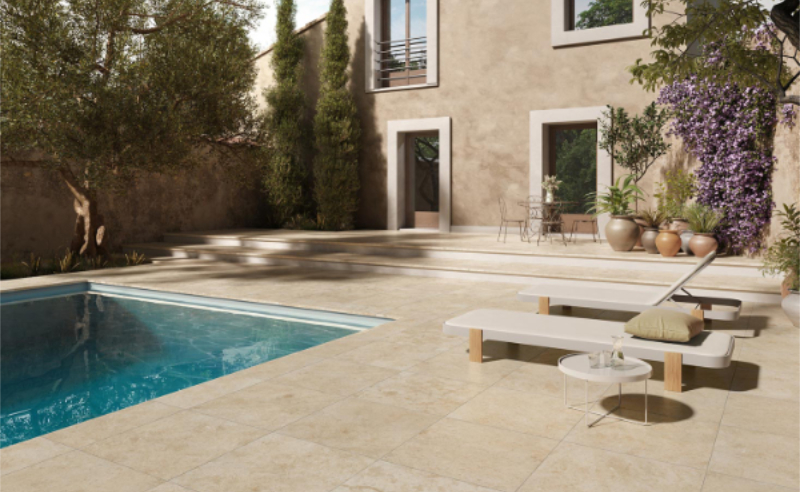
Special pieces and coping tiles
For a harmonious finish of your space, Novoceram offers you a complete range of porcelain stoneware pool coping, edges and grids that match with all our Outdoor Plus collections in 2 cm thickness. Pool coping tiles and other special pieces have different types of edges depending on the style you desire. You can choose a straight edge for a modern and contemporary effect, a quarter round, half-round or L-shaped edges to be laid along the pool for a perfect finish.
The many advantages of ceramic pool tiles
Novoceram offers porcelain tiles for swimming pool that have many advantages compared to other materials.
Firstly, swimming pool porcelain tiles highly resist to frost and temperature changes thanks to its almost zero porosity. The 2 cm thick tile can withstand temperature changes ranging from -50°C to +60°C. In addition, thanks to its resistance to chemicals, porcelain stoneware is impervious to de-icing salts.
Then, another important aspect is that pool ceramic tiles stand the test of time without undergoing major changes. For example, pool deck tiles are often exposed to the sun, but they are perfectly resistant to ultraviolet rays. Thus, their colour and finish do not darken or lighten in the sun. In addition, porcelain stoneware is resistant to chlorine and other products that are used to sanitise the pool, and therefore does not degrade.
Finally, hygiene is a key consideration for pools, whether they are private, public, in a hotel or another establishment. Ceramic swimming pool tiles are resistant to fungus, moss, mildew, and are not subject to blackening due to their inert nature and low porosity. That is why ceramic often ranks among the top in the best pool flooring.
Learn more about the other benefits of swimming pool porcelain tiles
Porcelain swimming pool tiles: Frequently Asked Questions
How can I maintain pool ceramic tiles?
Porcelain swimming pool tiles do not require any special treatment. Its daily cleaning could not be easier. You can also clean pool tiles with chemical products, even aggressive ones, because they are resistant to these. Of course, in this case, it is recommended to choose a professional brand. It is also possible to use a high-pressure cleaner, which is very practical for quickly and thoroughly cleaning large outdoor areas. If cleaned and maintained properly on a regular basis, your flooring tiles can have a very long life.
Do swimming pool tiles resist to chemicals?
Thanks to the technical properties and low porosity of porcelain stoneware, tiles are highly resistant to water corrosion and to the chemicals used in the pool for its maintenance. In other words, this material is ideal for pools!
Are resin style tiles suitable for floor and wall installation?
The colour of ceramic pool tiles depends heavily on the style you want to adopt. If the space is more contemporary, you may opt for a black tiled pool or anthracite grey pool tiles, both of which give some form of power to the pool area, for example, while a taupe tile gives a warm atmosphere. On the other hand, if you prefer a more Scandinavian style where light is the key word, then a pool with light coloured tiles such as ivory, which infuses its soft warmth and delicate tones in a quiet and serene atmosphere should be the ideal choice.
Projects with swimming pool tiles
Ceramic swimming pool tiles are, without a doubt, a suitable material for pools and their surroundings. Moreover, thanks to their numerous aesthetic effects, our collections are easy to combine with any decorative style. They highly personalise your decoration by providing the final touch that will make the difference. Here are a few images of our porcelain tiles for swimming pool that can serve as a source of inspiration... Feel free to send us your photos!

